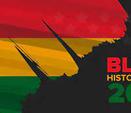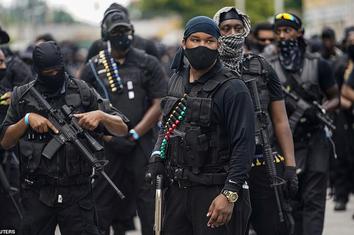Afrofuturism
Legislative
Vesey Government
Legislative
Executive
Judiciary
Foreign Policy
Defense
Bill of Rights
Bill or Rights
Armed Struggle and Creating a Black Nation-State
lllll
Vesey Republic Home
The Vesey Republic
Draft Program for A Majority Black-Led Nation-State
Governance Theory
8.30.2023
The Historical Role & NBNs Position on Armed Struggle in Creating a Black Nation-State
NBN's supports the right of self-determination of all oppressed people, nations, national minorities, and ethnic groups waging armed ‘people's wars’ to liberate themselves from the yoke of foreign and domestic domination.
The broad architecture of NBN's Battlespace doctrine emphasizes aggressive armed self-defense to defeat the Trump's seditious regime change enterprise and exploit American Empire's collapse to create independent Black national polities. As we will outline in this section, Battlespace draws heavily on the historical experience of the first three waves of territorial Black Nationalists to create independent Black nation-states and free communities.
As a general rule, armed struggle to win political power is necessary for any new social force to dismantle the old orders' coercive state machinery. Creating new instruments of state power like a people’s army, civilian militia, peace-keeping constabularies, justice systems, and laws are necessary to establish the government of a new sovereign nation or polity. For this reason, New Black Nationalists have offered new national government models for a Black nation-state on its website.
In NBN's Fanonist tradition, the use of force is based on a country's historical development and culture. America was born in blast furnace of the Revolutionary War against the British Empire, and genocide against the continents' indigenous natives. Two-hundred and fifty years of enslaving Black people was followed by a century of Jim Crow lynchings and policing Black communities with vigilantes, the Ku Klux Klan and occupying armies of state-sanctioned law enforcement. Thus, it stands to reason overthrowing America's imperial order requires armed struggle.
However, as discussed in NBN's article Frantz Fanon on Violence, we don't rule out non-violence or a mixed strategy of non-violence and armed struggle to win national liberation. India won national independence in 1947, from Britain in a non-violent struggle of protests and civil disobedience. South Africa's African National Congress (ANC) had distinct phases of mass non-violent struggle, an armed struggle phase, and an extended period settlement negotiations that were were punctuated by calculated violent actions to exact concessions and reach a final agreement 1994.
Lessons of the First Three Waves of Territorial Black Nationalist Struggle and 1960s Black Power Era
The 1st Wave exodus-centered territorial Black Nationalists (1739-1926) fought to create independent Black communities and homelands outside the United States. South Carolina’s 1739 Stono Rebellion attacked white planters while marching to Spanish Florida’s free Black settlement at Ft. Mose. Thousands of slaves shouldered arms with Britain in the 1776 Revolutionary War and the War of 1812 to win their freedom. They exited American Empire to establish free communities in Canada, Trinidad, London, and Freetown, Sierra Leone in West Africa.
In 1859 the polymath and father of Black Nationalism Martin Delaney was advocating a coordinated slave uprising in Cuba and across the Southern slavocracy. Anticipating the coming civil war, he was deliberately trying expose and spook Southern planters with the memory of Haiti's slave revolution who were attempting to persuade President Buchanan to purchase Cuba and expand slavery. A year later the civil war erupted. Close to 200,000 Blacks, who fought in the Civil War turned the conflict's tide to vanquish the Confederacy and liberate four million Blacks from slavery.
A common strand runs through the 1st Wave exodus experience. When America was confronted with wars and existential crises, Black Nationalists played all sides of the three-dimensional chessboard to win freedom and create new polities of self-rule from Africa to the Caribbean, to Canada. This is critical lesson as America edges toward civil war and a likely governmental collapse. The decline of Marcus Garvey's Back to Afrika movement in the mid 1920s, closed the chapter on the 1st Wave exodus-centered trend.
Second Wave (1916-1934) African Blood Brotherhood nationalists/socialists and 3rd International Communist theorists expanded Martin R. Delaney's 1852 articulation of Blacks as an Oppressed Nation Within a Nation. In a series of Moscow Comintern conferences (1925-1928), they posited a theory that Blacks constituted an oppressed nation formed in the Black Belt South's five states of Louisiana, Alabama, Georgia, Mississippi, and South Carolina. Broad opposition to the Black Belt Republic position adopted by the CP-USA at Joseph Stalin's insistence led to its abandonment in 1934.
It fell to the 3rd Wave territorial Black Nationalists of the Republic of New Afrika (RNA) to connect the Black Belt nation theory to the first major attempt to create an independent Black republic in the United States. At the RNA's 1968 founding convention in Detroit, a Provisional Government was created that included leading Black liberation movement figures. African nations and China were solicited to support the RNA's United Nations petition for a self-determination plebiscite. Republic of New Afrika consulates were opened around the country.
In 1970, the PG-RNA moved its headquarters from Detroit to Jackson, Mississippi. In part, they pursued a strategy to parley the mass Black urban rebellions into pressuring the United Nations to call for a national plebiscite on Black self-determination. The RNA also floated trial balloons to negotiate a truce with U.S. imperialist leaders to defuse the mass Black urban uprisings in exchange for ceding Mississippi and Alabama to them to launch the Black republic.
The RNA's attempts to leverage the ongoing Black rebellions to create a nation-state in the Black Belt reflected the difficulties of swimming upstream in the uncharted waters of nationhood. That said the RNA moved beyond the conventions of most radical Black Power groups seeking to implement variants of Malcolm X's articulation of armed community self-defense.
Targeted by the FBI's COINTELPRO program to destroy radical Black groups, Detroit Police and the FBI illegally raided the RNA's 1969 national convention which resulted in one police officer's death, and another being wounded. After moving the RNA's national office to Jackson in 1971, local police and the FBI raided an RNA residence close to Jackson State University. A Jackson police officer bit the dust.
In addition to forming its own Black Legion, various autonomous cells of the Black Liberation Army joined the Provisional Government of the RNA in 1968. Connected to several Black groups, these autonomous BLA cells carried out security details, helped form community self-defense units, appropriate monies from banks to support Black liberation forces, and spirited government-targeted Black revolutionaries out of the country to sanctuary and exile.
Unlike many radical and revolutionary organizations that formed in the 1960s Black Power movement, the PG-RNA survived the FBI COINTELPRO wars. Its offshoots, Cooperation Jackson and the Malcolm X Grassroots Movement also weathered the wilderness years after the 1960s Black Power movement ebbed and are rebuilding their organizations today. The RNA's theoretical contributions, Declaration of Independence, Umoja Constitution, and practical experience in creating a Black nation-state are indispensable to 4th Wave Black Nationalists' efforts to create a Black nation-state in the 2020s. We urge all our visitors to read Professor Edward Onaci's publication Free the Land on the PG-RNA.
Looking back at the 1960's, attempting to discern lessons on the role of armed struggle has real limitations. An argument can be made that for all the revolutionary forces of the 1960's anti-war movement, the New Marxist Movement inspired by the Cuban and Chinese revolution, and the Black Power movement, there was no attempt to overthrow the government or the articulation of a general strategy.
The lack of a revolutionary strategy reflected the fact that despite the radical uprisings and movements, U.S. imperialism was still relatively strong and supported by the overwhelming majority of the people. Among those buying in were the economically rising Black Commons who were moving into the middle-class, taking college degrees, and accumulating political power in urban centers across the country.
Nevertheless, sixties revolutionaries were operating on an inchoate set of general assumptions that they could bring the system down. The 1,2,3...Many Vietnams school of thought held that 3rd World liberation movements in Southeast Asia, Africa, the Caribbean and South America would overrun American Empire. As the story line went, the combination of Black urban rebellions and anti-Vietnam War movement striking inside the belly of the beast would finish off Pax Americana with the fatal blow.
The Maoist New Marxist Movements--some led by Black Marxists like poet Amiri Baraka fantasized that Black workers would lead a new multi-racial working-class movement to overthrow the government even as white workers clubbed white anti-war protesters with construction hard hats in liberal New York City and other cities and voted for George Wallace in the 1968 presidential elections. Still other New Marxists believed superpower contention between the U.S. and the Soviet Union would lead to a cataclysmic nuclear World War 3. It was theorized that like Lenin predicted in World War 1, the nuclear inter-imperialist war would lead to the downfall of one or both of the two superpowers. In the U.S., the working class would rise in a revolutionary war to destroy American imperialism amid the fallout of radioactive nuclear contamination wafting the breeze.
All these political currents ran deep in the theoretical waters of the surging Black Power movement during the sixties, including within the Provisional Government of the Republic of New Afrika that emerged as the flagship territorial Black Nationalists organization.
Thank you for reading The Historical Role of Armed Struggle in Creating a Black Nation-State. To continue reading The Integrated Battlespace Doctrine. This section also includes two case studies on role of armed struggle in the revolutions in India and South Africa following the document links below.
India's Non-Violence Revolution
Among Third World liberation struggles that toppled colonialism was India. Like Frantz Fanon, India's leader Mahatmas Gandhi shared Fanon's view that colonialism breeds national sickness. Both agreed their people would never be healed and their full humanity never restored without winning their independence. Their approaches, however, to the health needs of their people and violence could not have been more different.
Frantz Fanon was adamant about the need for armed revolution, particularly in those countries with colonial settler populations like India's occupation by the British. Gandhi was the apostle of peace and non-violence. As a doctor, Fanon was partial to surgery and antibiotics to remove malignant diseases. Gandhi preferred prayer, medication, hot baths, mud packs, and herbs.
Fanon believed the colonized must rise up to reclaim what was stolen from them, particularly lands that were expropriated. Gandhi believed Indians made too many excuses and should rely on their own initiative. Gandhi encouraged Indians to build their own schools instead of being educated by the British. He encouraged them to spin their own linen instead of buying imported British cloth, thereby breaking the back of Britain's economic exploitation of India.
Fanon was relentless in insisting the colonized must gain self-awareness and political consciousness to act on their own behalf for liberation. Gandhi's approach reflected India's majority Hindu religious and spiritual values of asceticism, self-control, discipline, inner strength, and resolve in seeking the way to happiness.
Hinduism as practiced in India also stood in sharp contrast to Islamic beliefs. Islam divides the world into dar-al-islam (the domain of Islam) and dar-al-harb (the domain of war). The irony of India's independence movement is that violence against the British was largely contained. But no sooner had independence been granted in India, did the nation's Hindu and Muslim populations engage in horrendous bloodletting and violence that ended in the partition of India and the creation of the Muslim state of Pakistan.
South Africa and Mandela's Middle Course - The Use of Limited Violence
If for arguments sake Fanon was the prophet of war and Gandhi the apostle of peace, how should we interpret the ''middle course" mapped by Nelson Mandela and the African National Congress on the issue of violence? From the article: Fanon on the Role of Violence in Liberation: A Comparison with Gandhi and Mandela, we have highlighted the following passages from author Gail Presbey's work.
How do the tenants of Fanon's constructs play against the grey area between violence and non-violence. In South Africa's case, the African National Congress's use of "limited violence" poses a set of interesting questions.
Presbey observes that "Nelson Mandela walks a fine line between these two thinkers, stressing the importance of non-violence while eventually turning to limited use of violence."
Presbey goes on to posit that, "The early strategy of the African National Congress (ANC) in South Africa was directly influenced by Gandhi's non-violent action. Albert Luthuli, a Zulu chief who was elected president of the ANC in 1952, led campaigns of massive disobedience against unjust laws in a Defiance Campaign. He insisted as late as 1962 that non-violence as a method must be strictly adhered to because 'as long as our patience can be made to hold out, we shall not jeopardize the South Africa of tomorrow by precipitating violence today.'
Presbey further inveighs that "Nelson Mandela and members of the ANC in South Africa also assumed and feared that retaliatory violence would escalate when they decided to form Umkonto we Sizwe and consequently used limited violence for their cause. The lack of progress, and the continued hardships of living under apartheid, made the resistance movement in South Africa decide to make the stakes higher. "
Presbey concludes that Mandela and the ANC used a careful selection process for a method of violence that would take the least lives. Carefully chosen sites for sabotage would cripple the economy and make a point: but lives would not be taken because of special concern for the healing process, since avoiding direct loss of lives 'offered the best hope for future race relations.' said Mandela.
Mandela noted that part of the ANC decision to depart from their long history of non-violent struggle resided in the fact that the people were no longer satisfied with non-violence and yearned for violent expression of their anger.
Mandela was afraid that if the ANC did not make itself relevant to the needs of the people by giving them the guidance and the structure required for a limited and calculated use of force against apartheid, the people would find their own, and perhaps more destructive, ways to express the violence they desired.
Having considered Presbey' s snapshot of Mandela and the ANC's thinking on the role of violence in the liberation movement, we will now offer some observations about Mandela and the ANC's overall approach to incorporating armed struggle into its liberation movement.
Factors Influencing Mandela and the ANC's Use of Violence:
- Mandela and the ANC's assessment was that a full-blown armed struggle for power would likely result in a long bloody war that would end in a stalemate, but with severe losses on both sides and the destruction of South Africa's economic base.
- A long indecisive civil war would ultimately result in horrendous acts of bloodshed committed by both sides. But ANC atrocities would diminish their moral high ground and international standing as a just struggle against white minority-rule. The ANC believed the potential loss of support of Western governments would severely deprive their post-apartheid government of valuable aid needed to run the country.
- The ANC eventually employed armed struggle to turn up the economic and political pressure on the white-minority National Party. In commencing armed struggle, they sought to prevent more radical elements inside and around the ANC's orbit from taking up the armed struggle outside the ANC's central command structure.
- The ANC's version of armed struggle focused on sabotage, attacks on infrastructure and economic targets that limited the loss of life. Inside South Africa armed forces did not concentrate their efforts on seizing and controlling large areas of the country.
- The nature of the ANC's armed attacks and military operations did not involve intensive mass recruitment and active day-to-day participation of millions of people in the armed struggle. It appears the ANC ran a number of operations by more specialized units.
- Mandela was willing to make serious even deep concessions to South Africa's white minority in order to create a unity government that would be seen as an authentic multi-racial, multi-party democracy. Large-scale armed struggle to win state power went against the grain of the ANC's central strategy to take control of the country through negotiations and elections as the new majority ruling party.
South Africa's African National Congress (ANC) had distinct phases of mass non-violent struggle, an armed struggle phase, and then an extended negotiated settlement in 1994. Among other things, the ANC agreed to dismantle the countries' nuclear program, eliminating the possibility of Black nuclear-armed state.
The Integrated Battlespace Doctrine
August 28, 2023
"The defenses of the colonized are tuned like anxious antennae waiting to pick up the hostile signals of a racially divided world. In the process, the colonized acquire a peculiar visceral intelligence dedicated to the survival of body and soul."
Frantz Fanon, Wretched of the Earth
Document Table of Contents
NewBlackNationalism.com



